Have you ever been lured by the aroma of a simmering pot of desi aromatic rice? Isn’t it the most comforting smell ever? Many of us might have forgotten what it is to come home to a piping hot bowl of khichri made using an heirloom variety of small-grained aromatic rice. And it is not just the khichri but also such desi rice varieties that have escaped our memory. Long before the slim, white and long-grained basmati took over as the rice of choice, the Krishna Kamod, Jeera-saar, Kolam, Masuri, and likes ruled the roost. Krishna Kamod, prized for its taste and aroma, was the rice of choice in our household. My mother always insisted we only use Kamod ni Kanki (broken rice) to make handvo-dhokla. Until I began exploring the Gujarati foodways and stumbling upon recipes that demanded using a specific variety of vegetables and grains and how it impacts the overall taste and texture of the food, I had little or no appreciation for heirloom produce. But now that I have experienced the goodness of it all as a mindful consumer and a cook, I refuse to go the other way.
So when I was to make this rice Handvo, I insisted on going by my mother’s choice of Krishna Kamod rice. And after devouring it, I also insist on calling it KRISHNA KAMOD Chokha no Handvo. Moving a little away from the traditional rice + lentil + veggies combination, this rice handvo excludes lentils yet has a very soft crumb (which remained soft on the following day as well). The use of Krishna Kamod rice makes this handvo soft and fragrant. And that superior crust, which is a benchmark to a good handvo is a bonus!!
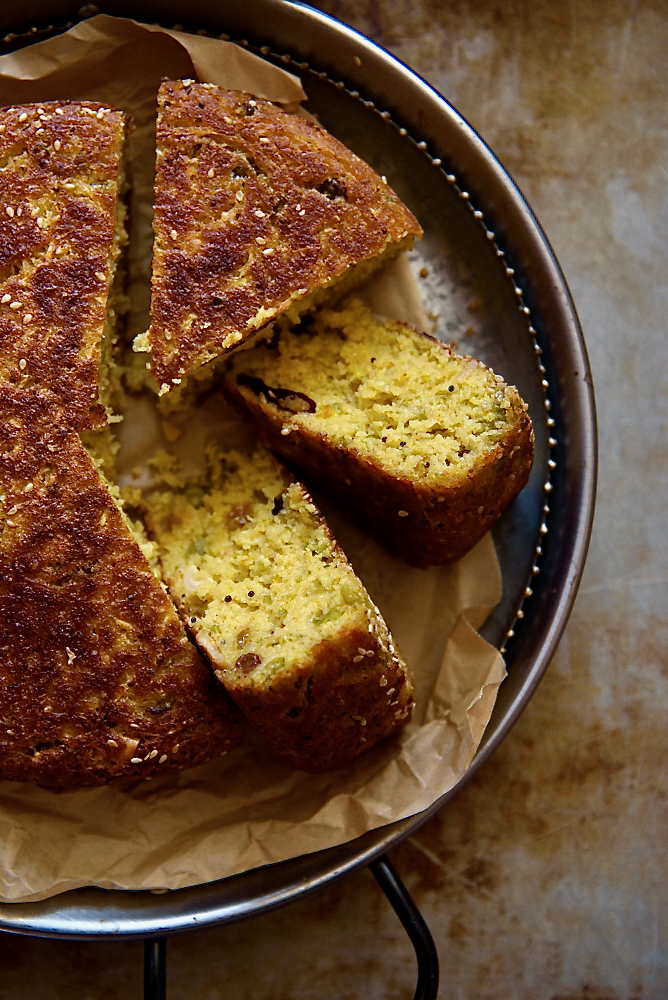
Handvo and Dhokla are the two most famous exports of Gujarati cuisine. And if you are well versed with Gujarati cooking ways, you are sure to churn-up numerous varieties of slow and instant versions of both these farsan. Yes, they fall under the category of farsan/snack. However, they can happily qualify for a one-pot meal. The contents of conventional Handvo-Dhokla flour are rice+lentils with millets added to liking. Still, if you choose to be adventurous and break the boundaries, the sky is the limit with the options to create these farsans. While most of us now prefer to use handvo+dhokla flour bought from the neighbourhood flour mill, the generations before us always had mixed and milled their own flour for Handvo-Dhokla mix. Care was taken to include an heirloom variety of glutinous and aromatic rice along with lentils, both in Kanki/broken form. The mixed grains were washed and sun-dried before milling. The flour mix makes a convenient option, especially for agrarian folks who tend to their farms in the early morning and lack time for the soak grains+grind+ferment ritual. Unlike the urban thali, where either of this duo can be part of the meal, the rural communities make Handvo or Dhokla for dinner and eat it with milk. Hence, they set the batter to ferment in the morning by mixing the flour with cultured sour buttermilk and go on to cook it for dinner which is usually before sunset.
The beginning notes to making them can be pretty similar i.e. you set the batter to ferment. After which, you can take it either way. Add a bunch of ingredients, bake it into a crusty handvo or keep it minimal and steam out spongy dhoklas. Either way, it is just as delicious.
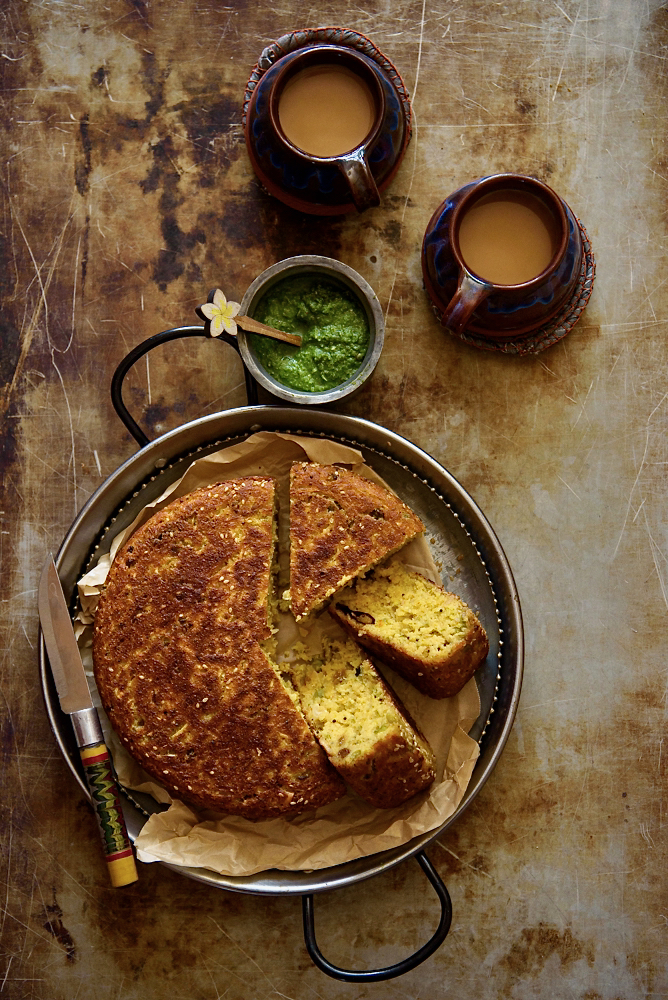
Krishna Kamod Chokha no Handvo
Ingredients
- 2 cups rice - small grained, glutinous, aromatic rice preferred
- 1 cup peas, boiled
- 1 cup bottle-gourd, grated
- 1 potato - medium, finely chopped
- 3/4 cup sour yogurt
- 1/2 cup broken cashews
- 2 tablespoons raisins
- 1 tablespoon jaggery/sugar
- 4 tablespoons ginger+chilli paste
- 1 inch fresh turmeric rhizome, minced or 1/2 teaspoon turmeric powder
- 1/2 teaspoon red chilli powder
- 1 teaspoon mustard seeds
- 1/4 cup sesame seeds
- 1/2 teaspoon asafoetida
- 4-5 dried red chillies, round ones preferred
- 2 cloves
- 1 inch cinnamon stick
- 1/4 cup oil, preferably groundnut oil
- 1/4 cup coriander, chopped
- salt to taste
- 1/4 teaspoon baking soda
Instructions
Wash and soak the rice for 5-6 hours
After the rice has soaked, drain and grind it to a coarse batter.
Transfer the batter to a stainless steel or ceramic bowl.
Add the yogurt to the batter. Mix well.
The consistency of the batter should be thicker than ildi batter.
Allow the batter to ferment over-night or 6-8 hours.
Once the batter has fermented, add the boiled peas, grated bottle-gourd, chopped potatoes, ginger + chilies, minced turmeric, red chilli powder, jaggery and salt. If required, add some water to bring the batter to idli batter/cake consistency.
Heat 3 tablespoons oil in a small kadai over medium flame. Add half the mustard seeds, half the sesame seeds, asafoetida, cloves, cinnamon, red chillies, cashews, raisins and add the tempered mix to the rice-veggie batter.
In a well seasoned skillet, add 1 tablespoon oil, add the remaining mustard and sesame seeds. Pour the batter over the oil, level and cover it. Cook the handvo on a gentle flame. Once the top of the Handvo has firmed up, and you notice a golden brown crust at the bottom flip the handvo with the help of a plate and slide the uncooked side on to the skillet. Pour some oil on the sides and cook the other side to golden brown. Remember to keep the flame low at all the times.
By now a skewer inserted in the centre of the Handvo will come out clean. Turn off the flame when that happens.
10 minutes after you have turned off the flame, transfer the Handvo on a wire rack and let the crumb set.
Cut it into wedges and serve with pickle or your choice. Green chutney also works well. And don't forget the a cup of masala chai.
The other Handvo recipes I have documented here are


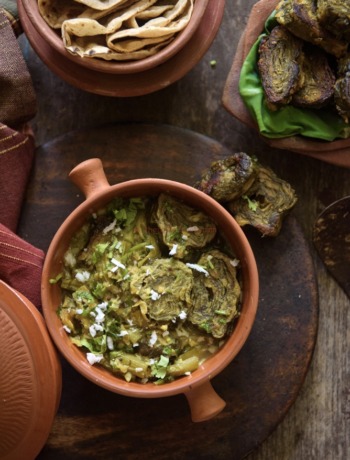
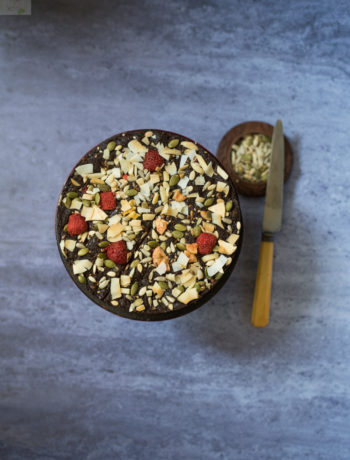
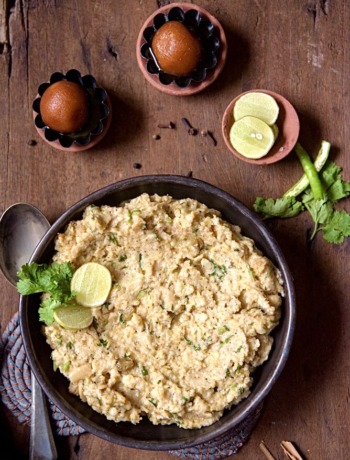
1 Comment
Seema
August 13, 2022 at 6:18 pmSend video of handvo